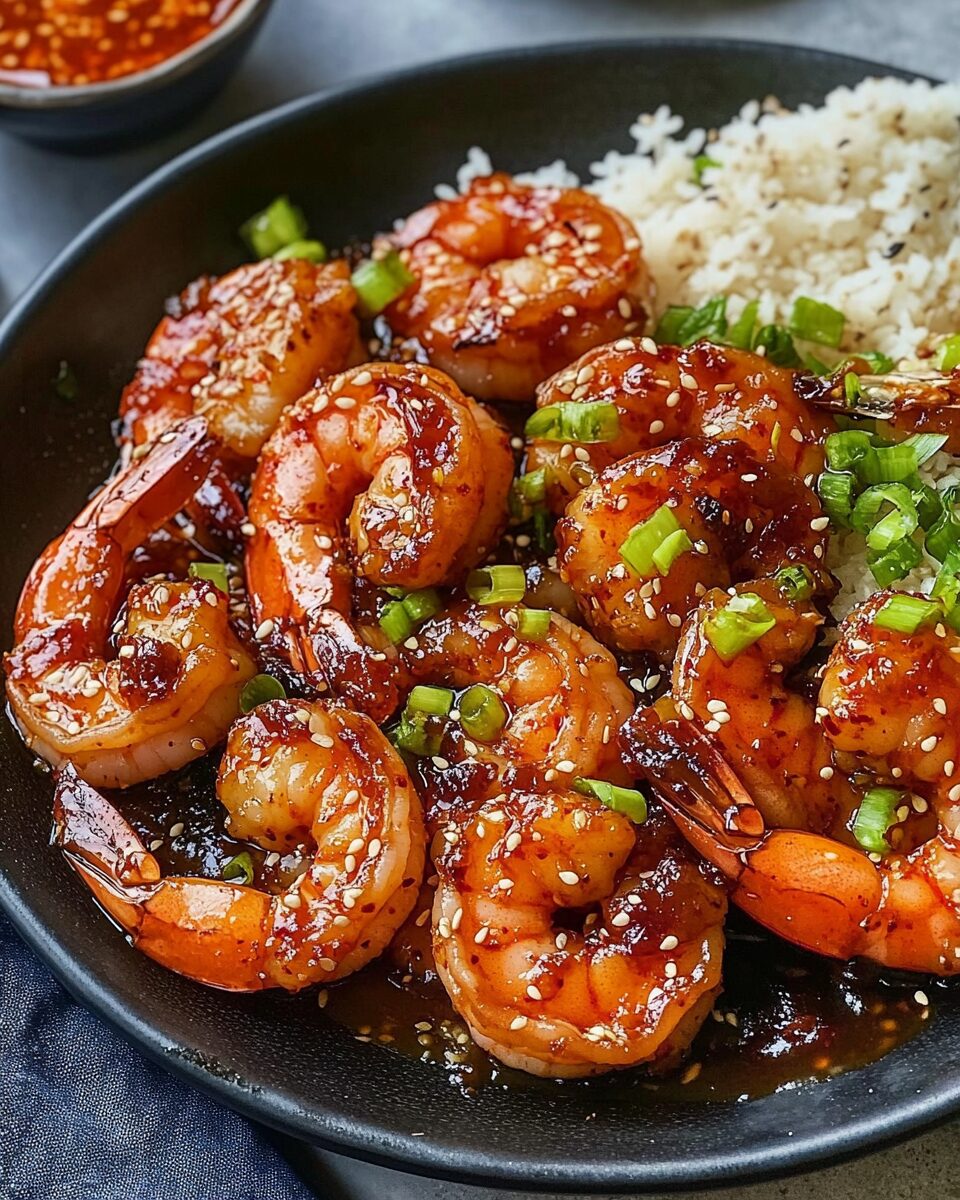The perfect blend of heat, sweetness, and umami comes together in this Korean Gochujang Shrimp recipe. These crispy shrimp are coated in a rich, sticky sauce that delivers big flavor in every bite. With simple pantry ingredients and just 20 minutes, it’s ideal for a satisfying weeknight dinner or an impressive quick meal for guests.
What’s truly exciting about this dish is how customizable it is—adjust the spice level, serve over jasmine rice or cauliflower rice, or pair with sautéed vegetables for a balanced meal. This is a go-to recipe for spice lovers and anyone who wants to experience bold Korean-inspired flavors at home.
Full recipe:
Ingredients:
-
10 oz large shrimp, shelled with tails on
-
1 egg
-
½ cup arrowroot powder (or cornstarch)
-
¼ tsp salt
-
¼ tsp black pepper
-
½ tsp garlic powder
-
1–2 tbsp avocado oil
-
1 tbsp sesame oil
-
2 garlic cloves, minced
-
⅓ cup scallions, chopped (plus 1 tbsp for garnish)
-
2 tbsp gochujang paste
-
3 tbsp honey (or maple syrup)
-
1 tbsp coconut aminos (or soy sauce/tamari)
-
1 tbsp apple cider vinegar
-
2 tbsp water
-
2 tsp white sesame seeds
-
Lime wedges (optional, for serving)
Directions:
-
In a small bowl, add the shrimp and crack in the egg. Toss until all shrimp are well coated.
-
In another bowl, mix arrowroot powder with salt, pepper, and garlic powder.
-
Dredge each shrimp in the arrowroot mixture and place on a plate.
-
Heat avocado oil in a large skillet over medium-high heat.
-
Fry shrimp in batches (single layer), about 2 minutes on one side, flip, and cook another 1-2 minutes until golden and crispy. Transfer to a plate.
-
Wipe skillet clean and add sesame oil. Sauté minced garlic and chopped scallions for 2 minutes.
-
Stir in gochujang paste, honey, coconut aminos, apple cider vinegar, and water. Simmer for 3–4 minutes until thickened.
-
Return shrimp to the skillet and toss to coat in sauce.
-
Garnish with sesame seeds, fresh scallions, and lime wedges. Serve hot.
Prep Time: 10 minutes | Cooking Time: 10 minutes | Total Time: 20 minutes
Kcal: 196 kcal | Servings: 4
The Allure of Gochujang
At the heart of this dish is gochujang, a traditional Korean fermented chili paste that has been a cornerstone of Korean cuisine for centuries. Its ingredients—red chili powder, glutinous rice, fermented soybeans, and salt—are fermented over months to develop a complexity that’s hard to replicate. What sets gochujang apart from other chili sauces is not just its heat, but the natural sweetness from the rice and a deep, earthy savoriness from fermentation. It’s a flavor bomb.
In Korean households, gochujang is a pantry essential used in stews, marinades, dipping sauces, and soups. Now, thanks to its growing popularity worldwide, it’s becoming a staple in kitchens around the globe.
Why Gochujang Works So Well with Shrimp
Shrimp has a naturally sweet, slightly briny flavor that acts as the perfect canvas for bold sauces. When seared until golden, it develops a light crust that gives texture and seals in moisture. The addition of gochujang sauce elevates the shrimp with a bold, spicy edge that doesn’t overpower but enhances its sweetness.
What truly makes this combination magical is balance. The gochujang brings the heat and funk, the honey or maple syrup lends sweetness, and soy sauce or coconut aminos add that much-needed umami. A dash of acidity from apple cider vinegar ties everything together, cutting through the richness with a clean, sharp finish.
A Quick and Easy Weeknight Option
One of the biggest draws of this dish is just how easy it is to make. With less than 10 minutes of prep and about 10 minutes of cook time, Gochujang Shrimp is the answer to your “what’s for dinner?” question on even the busiest nights.
Because it uses basic pantry ingredients and minimal steps, it’s incredibly accessible for home cooks of all levels. There’s no marinating needed, no complicated techniques—just a bit of dredging and a fast fry followed by tossing in sauce.
Customizing the Spice Level
Gochujang varies in heat level depending on the brand and specific recipe. While the base recipe is about a 6 or 7 out of 10 on the spicy scale, it’s easy to adjust:
-
Want it milder? Use less gochujang or mix it with a bit of tomato paste or ketchup to mellow it.
-
Craving more heat? Add a pinch of crushed red pepper flakes, a drizzle of chili oil, or even fresh chili slices into the sauce.
This makes the dish family-friendly, especially if you’re cooking for a mix of spice lovers and milder palates.
Great for Meal Prep and Make-Ahead Dinners
Although best served fresh, Gochujang Shrimp can absolutely be prepped ahead. Both the shrimp and sauce can be prepared and stored separately for up to three days. Simply reheat the shrimp in a skillet or air fryer to regain its crisp texture, warm the sauce, and toss together just before serving.
This also makes it perfect for meal prep: portion the cooked shrimp with rice and vegetables in containers, and you’ve got lunch ready to go for several days. Just be sure to let the shrimp cool to room temperature before sealing them in airtight containers to avoid sogginess or overcooking during reheating.
Perfect Pairings for Gochujang Shrimp
This dish is versatile enough to be served in multiple ways depending on your dietary needs or mood:
-
Cauliflower rice: A low-carb option that complements the bold sauce without overpowering it.
-
Steamed white rice or jasmine rice: The traditional choice that soaks up the flavorful sauce beautifully.
-
Brown rice or quinoa: Adds a hearty, nutty base.
-
Stir-fried or roasted vegetables: Think broccoli, green beans, zucchini, or bell peppers.
-
Asian-style slaw: Something crunchy and tangy balances the richness of the shrimp.
You can even use the shrimp in lettuce wraps or taco shells for a fun fusion twist.
Is It Healthy? Yes—and Easily Adjustable
This Gochujang Shrimp dish is naturally dairy-free and can be adjusted to suit a variety of dietary lifestyles:
-
Gluten-Free: Simply use coconut aminos or tamari instead of soy sauce.
-
Whole30: Swap honey for date syrup or eliminate sweetener entirely.
-
Keto-Friendly: Use a sugar-free substitute like monk fruit or erythritol-sweetened syrup.
Arrowroot powder, used for coating the shrimp, gives that light, crispy texture without the need for flour. Alternatively, cornstarch or tapioca starch works just as well.
Because it’s protein-rich and relatively low in carbs (depending on what you serve it with), this dish fits into many wellness-focused eating plans.
Korean Cuisine’s Rising Influence
The rising popularity of Korean dishes like kimchi, bibimbap, and gochujang chicken is no coincidence. Korean cuisine offers a unique balance of spice, fermentation, and umami that appeals to a global palate. Gochujang Shrimp is part of this wave, bridging the gap between traditional Korean cooking and modern fast-casual home meals.
With the ease of sourcing gochujang from mainstream grocery stores or online retailers, it’s never been easier to introduce authentic Korean flavors into your home kitchen.
Serving Tips for Maximum Appeal
Presentation plays a big role in making this dish restaurant-worthy:
-
Garnish with toasted sesame seeds and sliced scallions for a pop of color and texture.
-
Serve with lime wedges for added zing.
-
Plate it in a shallow bowl or rustic cast iron pan for that cozy, homey feel.
If you’re planning to feature this dish at a dinner party or on your blog/social feed, a backdrop of neutral colors (white rice, light wood, minimal greens) will make the vibrant red-orange hue of the gochujang sauce stand out even more.
Leftover Ideas You’ll Love
Leftovers (if you have any!) can be creatively repurposed:
-
Shrimp rice bowls: Add avocado, cucumber, and a fried egg.
-
Shrimp tacos: Top with slaw and drizzle with extra gochujang mayo or spicy aioli.
-
Asian pasta stir-fry: Toss shrimp and extra sauce with soba noodles or udon.
-
Gochujang shrimp salad: Serve chilled on top of a bed of greens with sesame dressing.
Just remember not to reheat the shrimp too aggressively. A gentle warm-up ensures they don’t become rubbery.
Conclusion: A Dish Worth Repeating
Gochujang Shrimp is a flavor-packed dish that offers everything you want in a meal: fast, easy, adaptable, and incredibly satisfying. With bold Korean influences, minimal ingredients, and a quick cooking process, it’s the kind of dish that becomes a go-to in any kitchen.
Whether you’re new to Korean cuisine or a longtime fan, this dish introduces you to the beauty of sweet heat, fermented complexity, and shrimp done right. So next time you want something different yet comforting, spicy but balanced, make this Gochujang Shrimp your main course. One bite, and you’ll see why it’s quickly becoming a favorite around the globe.
Let it become a staple in your weekly rotation—it’s easy, exciting, and endlessly crave-worthy.






